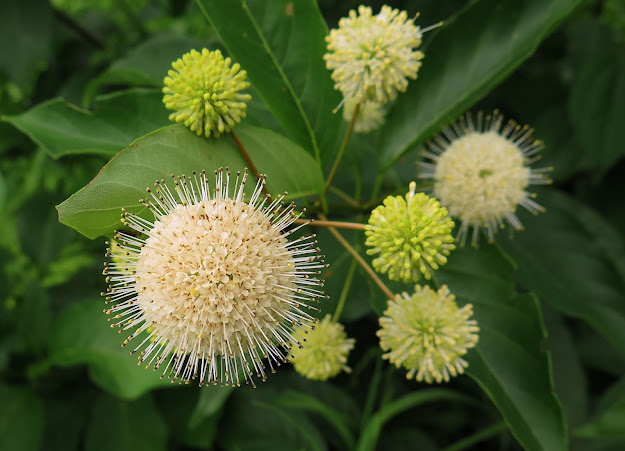The day was perfect: high 70s, no wind, no rain, blue skies, puffy clouds. And so was the river: quiet water to mirror the sky, no power boats to roil the surface, wooded and rocky islands teeming with flowers, forested mountains bringing their green right down to the water's edge, leafy boughs shading the banks. This is the Hudson River at Moreau. A paddler's dream!
This pine-shaded spot with gorgeous views was where we sat to enjoy our picnic lunches.
And to make it even better, I had my good pal Sue with me, a friend who knows how to inch along the shore in no hurry, her sharp eyes alert to fascinating finds along the way. I wonder what she's found here?
Oh my goodness, it's
orchids! Beautiful orchids, with bright-purple florets, a patch of five of them! Believe it or not, these are the
Smaller Purple-fringed Orchids (
Platanthera psycodes).
Apparently, one of our recent wind-and-rain storms had toppled this top-heavy bloomer. And yet, the multi-flowered inflorescence had managed to right itself and re-achieve its vertical stature. It still has over half of its florets still to open.
As we continued to mosey along the banks, we found many other flowers to marvel at, such as this hedge of Fringed Loosestrife (
Lysimachia ciliata) crowding the shore.
Here's a closer look at the Fringed Loosestrife's pretty yellow flowers, their centers ringed with red. (By the way, if you're looking for fringes, they're found on the leaf petioles and not visible in this photo.)
We saw many stalks of Joe-Pye Weed (
Eutrochium maculatum) towering above the surrounding vegetation, but only a few had opened their frothy lavender blooms as yet. But this one had.
Several species of wildflowers were remarkably tall, reaching for the light from where they were growing under the trees. This pink-flowered plant living up to its name is Showy Tick-trefoil (
Desmodium canadense).
This blue-flowered one is Blue Vervain (
Verbena hastata).
More pretty blue flowers: these are called Monkey Flower (
Mimulus ringens), and they have many more buds still to open.
Here's one of our native spiraeas, a deep-pink one called Steeplebush (
Spiraea tomentosa) because of its long narrow flower spike. The specific name
tomentosa refers to the layer of matted woolly down ("tomentum") that covers its stem and the backs of its leaves. Another vernacular name for this native plant is Hardhack, and I have no idea what suggested that odd name.
And here's the queen of the showy riverside flowers, the magnificent Cardinal Flower (
Lobelia cardinalis), just beginning to open its knock-your-eye-out-red blooms. The riverbank show has just begun!
From the super-showy Cardinal Flower to the modest and oddly made Ditch Stonecrop (
Penthorum sedoides)! I had to peer closely among the surrounding low vegetation to spy its small greenish flowers. I don't really have the botanical vocabulary to describe these pudgy blooms, except to state that they seem to have no petals at all, just some bulbous female parts in the middle, surrounded by the male stamens. These flowers achieve their true beauty in autumn, when their curving inflorescences (now turned into fruits) take on a deep ruby-red color.
What may look like little green flowers at the center of these smooth leaf clusters are really the bracts that will later hold the royal-blue urn-shaped blooms of Closed Gentian (
Gentiana clausa), one of our most beautiful autumn-blooming wildflowers, which thrives along these shores. It's definitely worth a return in September to witness these gorgeous flowers.
And we may want to return much sooner than that, to enjoy not just the beauty but also the taste of these not-yet-ripe Lowbush Blueberries. Or are they Black Huckleberries? Gosh, I should have examined the plants more closely, but I was distracted by how pretty and pink these berries were. Either species, they promise a tasty treat!
After paddling close to the riverbanks for most of the morning, we next headed out to some mid-stream islands. First, we enjoyed our picnic lunches under the shade of two towering White Pines (see the fourth photo down from the top, above), and then we set out to see what aquatic plants were thriving in the shallow water surrounding the islands.
Hundreds of white dots of Northern Pipewort (
Eriocaulon aquaticum) decorated these shallows, many of them blooming away underwater, with only a few popping their small white heads above the surface.
Numerous plants of Grass-leaved Arrowhead (
Sagittaria graminea) held their pristine-white three-parted flowers clear of the shallow water, surrounded by the narrow blades of their grass-like leaves.
I don't know if there is a single plant that could be called the most prolific bloomer along this stretch of the river, but if there were, Golden Pert (
Gratiola aurea) would be a top contender. Oddly, much of the year you wouldn't even know it was here, as its vivid green leaves quietly cover vast tracts of the river bottom and creep within underwater cracks in the riverside rocks. But let the water recede and expose the plants to air, and almost overnight, those vast tracts and rocky cracks explode with tiny, trumpet-shaped bright-yellow blooms. The river was rather low today, so we were treated to a few massed displays of this truly lovely riparian wildflower.
What a wonderful stretch of the Hudson River, here where it flows past the Palmertown Mountains and forms the northern boundary of Saratoga County! I feel so at home here, lucky to know this river as if it were my own, and happy to share it with all the creatures who also make it their home. Creatures like these Canada Geese, a family group I imagine, who must have felt safe enough in my presence to just go on with their dabbling as if I were not here.



































































